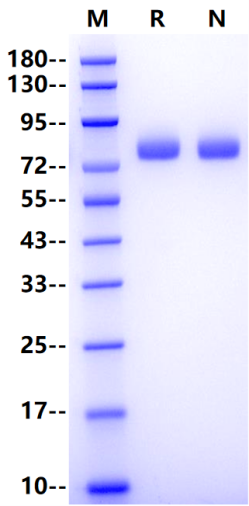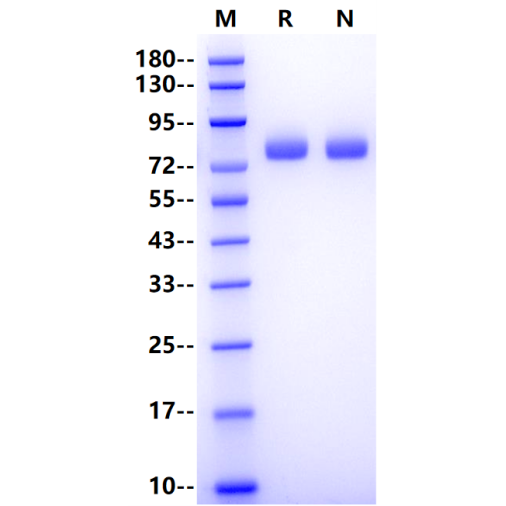Product Details
Product Details
Product Specification
| Species | Human |
| Synonyms | CD36, SR-B3, SCARB3, BDPLT10, CHDS7, FAT, GP3B, GP4, GPIV, PASIV |
| Accession | P16671 |
| Amino Acid Sequence | Gly30-Asn439, with C-terminal 10*His GDLLIQKTIKKQVVLEEGTIAFKNWVKTGTEVYRQFWIFDVQNPQEVMMNSSNIQVKQRGPYTYRVRFLAKENVTQDAEDNTVSFLQPNGAIFEPSLSVGTEADNFTVLNLAVAAASHIYQNQFVQMILNSLINKSKSSMFQVRTLRELLWGYRDPFLSLVPYPVTTTVGLFYPYNNTADGVYKVFNGKDNISKVAIIDTYKGKRNLSYWESHCDMINGTDAASFPPFVEKSQVLQFFSSDICRSIYAVFESDVNLKGIPVYRFVLPSKAFASPVENPDNYCFCTEKIISKNCTSYGVLDISKCKEGRPVYISLPHFLYASPDVSEPIDGLNPNEEEHRTYLDIEPITGFTLQFAKRLQVNLLVKPSEKIQVLKNLKRNYIVPILWLNETGTIGDEKANMFRSQVTGKINGGGSGGGSHHHHHHHHHH |
| Expression System | HEK293 |
| Molecular Weight | 74-84kDa |
| Purity | >95% by SDS-PAGE |
| Endotoxin | <0.1EU/μg |
| Conjugation | Unconjugated |
| Tag | His Tag |
| Physical Appearance | Lyophilized Powder |
| Storage Buffer | PBS, pH7.4 |
| Reconstitution | Reconstitute at 0.1-1 mg/ml according to the size in ultrapure water after rapid centrifugation. |
| Stability & Storage | · 12 months from date of receipt, lyophilized powder stored at -20 to -80℃. · 3 months, -20 to -80℃ under sterile conditions after reconstitution. · 1 week, 2 to 8℃ under sterile conditions after reconstitution. · Please avoid repeated freeze-thaw cycles. |
| Reference |
1、Forte E. et al. (2018) The interstitium in cardiac repair: role of the immune-stromal cell interplay. Nat Rev Cardiol. 15: 601-616. 2、Coraci I S. et al. (2002) CD36, a class B scavenger receptor, is expressed on microglia in Alzheimer’s disease brains and can mediate production of reactive oxygen species in response to -amyloid fibrils. Am. J. Pathol. 160: 101-112. |
Background
CD36 belongs to the scavenger receptor class B (SR-B), a family of highly glycosylated transmembrane receptors with a wide range of ligand recognition sites. It has been reported that glycosylation of CD36 is required for trafficking of intracellular CD36 to the cell surface membrane. Because of its wide range of ligands, CD36 has plenty of functions, including but not limited to recognizing and ingesting lipids, participating in the process of inflammatory response, signal transduction, and apoptosis. The expression occurs in monocytes/macrophages and microglia as well as various other cells and tissues, including microvascular endothelial cells, platelets, adipocytes, and the heart. CD36 promotes the podocyte injury in many kidney diseases including primary nephrotic syndrome, obesity-related glomerulopathy, and diabetic nephropathy. Moreover, genetic knockout or antagonist blockade of CD36 could alleviate kidney injury indicating that CD36 is a potential therapeutic target.
Picture
Picture
SDS-PAGE

1μg (R: reducing conditions, N: non-reducing conditions).


